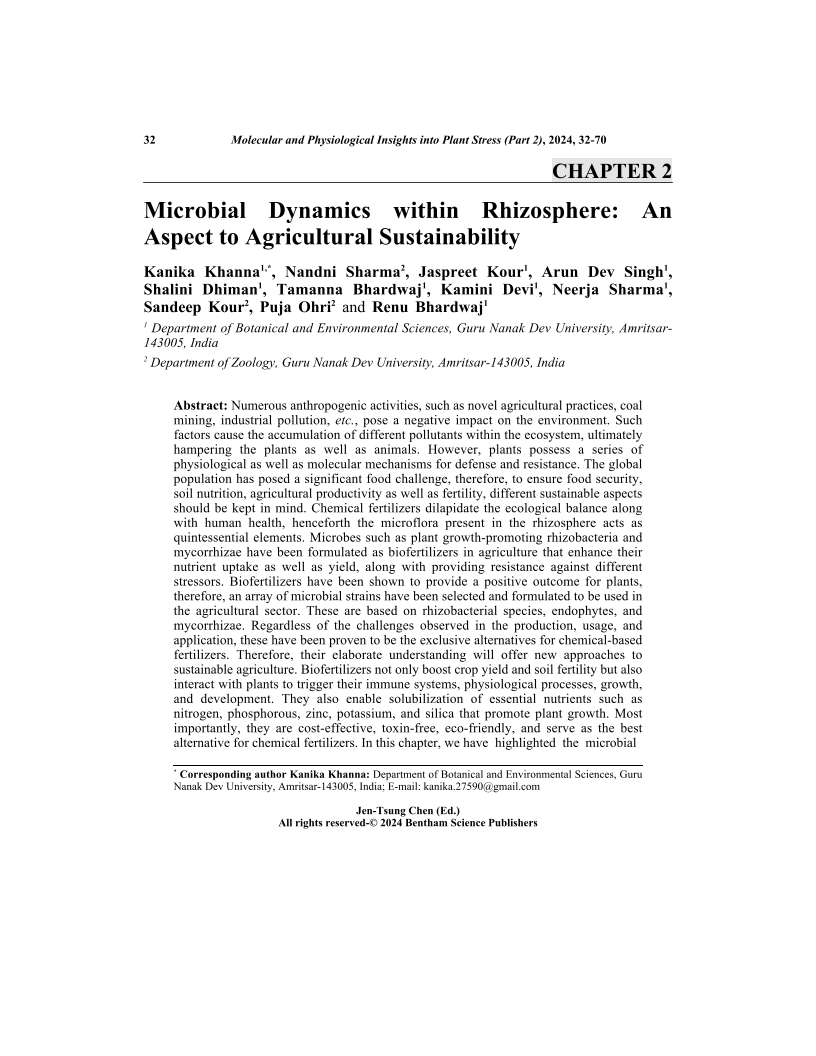Microbial Dynamics within Rhizosphere: An Aspect to Agricultural Sustainability

- Authors: Tamanna Bhardwaj1, Kanika Khanna2, Nandni Sharma3, Jaspreet Kour4, Arun Dev Singh5, Shalini Dhiman6, Kamini Devi7, Neerja Sharma8, Sandeep Kour9, Puja Ohri10, Renu Bhardwaj11
-
View Affiliations Hide Affiliations1 Department of Botanical and Environmental Sciences, Guru Nanak Dev University, Amritsar143005, India 2 Department of Botanical and Environmental Sciences, Guru Nanak Dev University, Amritsar143005, India 3 Department of Zoology, Guru Nanak Dev University, Amritsar 143005, India 4 Department of Botanical and Environmental Sciences, Guru Nanak Dev University, Amritsar- 143005, India 5 Department of Botanical and Environmental Sciences, Guru Nanak Dev University, Amritsar143005, India 6 Department of Botanical and Environmental Sciences, Guru Nanak Dev University, Amritsar143005, India 7 Department of Botanical and Environmental Sciences, Guru Nanak Dev University, Amritsar143005, India 8 Department of Botanical and Environmental Sciences, Guru Nanak Dev University, Amritsar- 143005, India 9 Department of Zoology, Guru Nanak Dev University, Amritsar-143005, India 10 Department of Zoology, Guru Nanak Dev University, Amritsar-143005, India 11 Department of Botanical and Environmental Sciences, Guru Nanak Dev University, Amritsar143005, India
- Source: Molecular and Physiological Insights into Plant Stress Tolerance and Applications in Agriculture- Part 2 , pp 32-70
- Publication Date: February 2024
- Language: English
Microbial Dynamics within Rhizosphere: An Aspect to Agricultural Sustainability, Page 1 of 1
< Previous page | Next page > /docserver/preview/fulltext/9789815179699/chapter-2-1.gif
Numerous anthropogenic activities, such as novel agricultural practices, coal mining, industrial pollution, etc., pose a negative impact on the environment. Such factors cause the accumulation of different pollutants within the ecosystem, ultimately hampering the plants as well as animals. However, plants possess a series of physiological as well as molecular mechanisms for defense and resistance. The global population has posed a significant food challenge, therefore, to ensure food security, soil nutrition, agricultural productivity as well as fertility, different sustainable aspects should be kept in mind. Chemical fertilizers dilapidate the ecological balance along with human health, henceforth the microflora present in the rhizosphere acts as quintessential elements. Microbes such as plant growth-promoting rhizobacteria and mycorrhizae have been formulated as biofertilizers in agriculture that enhance their nutrient uptake as well as yield, along with providing resistance against different stressors. Biofertilizers have been shown to provide a positive outcome for plants, therefore, an array of microbial strains have been selected and formulated to be used in the agricultural sector. These are based on rhizobacterial species, endophytes, and mycorrhizae. Regardless of the challenges observed in the production, usage, and application, these have been proven to be the exclusive alternatives for chemical-based fertilizers. Therefore, their elaborate understanding will offer new approaches to sustainable agriculture. Biofertilizers not only boost crop yield and soil fertility but also interact with plants to trigger their immune systems, physiological processes, growth, and development. They also enable solubilization of essential nutrients such as nitrogen, phosphorous, zinc, potassium, and silica that promote plant growth. Most importantly, they are cost-effective, toxin-free, eco-friendly, and serve as the best alternative for chemical fertilizers. In this chapter, we have highlighted the microbial dynamics within the rhizospheric zone and its significance in agriculture by its usage as biofertilizers for sustainable crop production.
-
From This Site
/content/books/9789815179699.chapter-2dcterms_subject,pub_keyword-contentType:Journal -contentType:Figure -contentType:Table -contentType:SupplementaryData105

